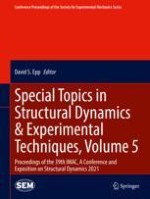2022 | Buch
Special Topics in Structural Dynamics & Experimental Techniques, Volume 5
Proceedings of the 39th IMAC, A Conference and Exposition on Structural Dynamics 2021
herausgegeben von: Dr. David S. Epp
Verlag: Springer International Publishing
Buchreihe : Conference Proceedings of the Society for Experimental Mechanics Series
